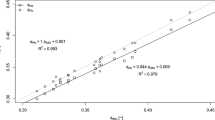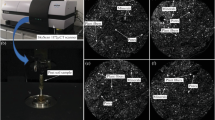Abstract
This research proposes an innovative Kriging-approximation simulated annealing (KASA) optimization algorithm to increase optimization efficiency and reduce the computation time for the parameter calibration of simulation model. The newly developed KASA optimization algorithm utilizes the simulated annealing algorithm to search the global optimum; meanwhile, Kriging approximation, a statistical estimation method, is incorporated with simulated annealing to interpolate unknown objective values in solution spaces. Furthermore, this research establishes a network-based porous media flow simulation (NET-PFS) model and then KASA is applied in the calibration of the NET-PFS representative pore network. NET-PFS is a pore network based model constructing a representative pore network to approximate soil characteristics and pore geometry with limited access to pore-scale imaging processes. NET-PFS is applied to estimate the permeability of a sand-packing porous media. NET-PFS establishes a framework for simplifying the pore network but remaining the same hydraulic conductivity and the flow status of pore networks with limited information about the pore structure. In the case study, a quartz sand-packing porous media is scanned by X-ray micro computed tomography. The NET-PFS model is applied to estimate the hydraulic conductivity and flow velocity distribution from the original pore network. The results demonstrate the proposed KASA algorithm effectively calibrated the NET-PFS model; in addition, a representative pore network and the determined flow status in the pore network is presented by NET-PFS.















Similar content being viewed by others
Abbreviations
- \({\text{i}}\) :
-
Unobserved points, \({\text{i}} = 1, 2, 3, \ldots ,{\text{m}}\)
- \({\text{j}}1,{\text{j}}2,{\text{k}}\) :
-
Observed points, \({\text{j}}1,{\text{j}}2,{\text{k}} = 1, 2, 3, \ldots ,{\text{n}}\)
- \({\text{r}}1,{\text{r}}2\) :
-
Pores, \({\text{r}}1,{\text{r}}2 = 1, 2, 3, \ldots , {\text{q}}1\)
- \({\text{r}}3\) :
-
Inner pores, \({\text{r}}3 = 1, 2, 3, \ldots , {\text{q}}3\)
- \({\text{r}}4\) :
-
Boundary pores, \({\text{r}}4 = 1, 2, 3, \ldots , {\text{q}}4\)
- \({\text{al}}_{{{\text{r}}1,{\text{r}}2}}^{{}}\) :
-
Length of the arc between pores \({\text{j}}1\) and \({\text{j}}2\)
- \({\text{ar}}_{{{\text{r}}1,{\text{r}}2}}^{{}}\) :
-
Diameter of the arc between pores \({\text{j}}1\) and \({\text{j}}2\)
- \({\text{dv}}\) :
-
Dynamic viscosity
- \({\text{d}}_{{{\text{j}}1,{\text{j}}2}}^{{}}\) :
-
Distance between points \({\text{j}}1\) and \({\text{j}}2\)
- \({\text{obj}}_{\text{new}}^{{}}\) :
-
New objective value
- \({\text{obj}}_{\text{current}}^{{}}\) :
-
Current objective value
- \({\text{p}}\) :
-
Number of simulated annealing iterations
- \({\text{pr}}_{{{\text{r}}4}}^{{}}\) :
-
Given node pressure at node \({\text{r}}4\) of the NET-PFS model
- \({\text{qa}}\) :
-
Number of arcs in the pore network
- \({\text{q}}1\) :
-
Number of pores in the pore network
- \({\text{q}}3\) :
-
Number of inner pores in the pore network
- \({\text{q}}4\) :
-
Number of boundary pores in the pore network
- \({\text{temp}}\) :
-
Temperature of the simulated annealing algorithm
- \({\text{tk}}\) :
-
Computational time of the Kriging approximation for the NET-PFS model
- \({\text{tn}}\) :
-
Computational time of the NET-PFS model
- \({\text{v}}_{\text{i}}^{\text{E}}\) :
-
Kriging estimation of a random variable at unobserved point \({\text{i}}\)
- \({\text{v}}_{\text{i}}^{\text{T}}\) :
-
Realization of a random variable at unobserved point \({\text{i}}\)
- \({\text{v}}_{{{\text{j}}1}}^{{}}\) :
-
Realization of a random variable at observed point \({\text{j}}1\)
- \({\text{w}}_{{{\text{j}}1}}^{{}}\) :
-
Kriging weight at point \({\text{j}}1\)
- \({\text{xf}}_{{{\text{r}}1,{\text{r}}2}}^{{}}\) :
-
Arc flow from nodes \({\text{r}}1\) to \({\text{r}}2\) of the NET-PFS model
- \({\text{xp}}_{{{\text{r}}1}}^{{}}\) :
-
Node pressure at node \({\text{r}}1\) of the NET-PFS model
- \({\text{xp}}_{\text{in}}\) :
-
Pore pressure at the inlet boundary
- \({\text{xp}}_{\text{out}}\) :
-
Pore pressure at the outlet boundary
- \({\text{z}}\) :
-
Random variable with a uniform distribution in the interval of [0,1]
- \(\upgamma( {{\text{d}}_{{{\text{j}}1,{\text{j}}2}}^{{}} } )\) :
-
Semivariogram function of distance \({\text{d}}_{{{\text{j}}1,{\text{j}}2}}^{{}}\)
- \(\uplambda\) :
-
Lagrange multiplier
- \(\upmu\) :
-
Expected values of the random variables
- \(\upsigma_{{}}^{2}\) :
-
Variance of the random variables
- \({\text{COV}}\) :
-
Covariance function
- \({\text{ERROR}}_{\text{i}}^{{}}\) :
-
Estimation error at unobserved point \({\text{i}}\)
- \({\text{EXP}}\) :
-
Expected value
- \({\text{EXPO}}\) :
-
Exponential function
- \({\text{LAGR}}_{\text{i}}^{{}}\) :
-
Lagrange function at unobserved point \({\text{i}}\)
- \({\text{Q}}_{\text{m}}\) :
-
Total flow rate
- \({\text{VAR}}\) :
-
Variance function
References
Al-Kharusi AS, Blunt MJ (2007) Network extraction from sandstone and carbonate pore space images. J Pet Sci Eng 56(4):219–231
Bakke S, Øren PE (1997) 3-D pore-scale modelling of sandstones and flow simulations in the pore networks. Spe J 2(02):136–149
Bechler A, Romary T, Jeannee N, Desnoyers Y (2013) Geostatistical sampling optimization of contaminated facilities. Stoch Environ Res Risk Assess 27:1967
Blunt MJ, Jackson MD, Piri M, Valvatne PH (2002) Detailed physics, predictive capabilities and macroscopic consequences for pore-network models of multiphase flow. Adv Water Resour 25(8):1069–1089
Blunt MJ, Bijeljic B, Dong H, Gharbi O, Iglauer S, Mostaghimi P, Paluszny A, Pentlanda C (2013) Pore-scale imaging and modelling. Adv Water Resour 51:197–216
Bryant S, Blunt M (1992) Prediction of relative permeability in simple porous media. Phy Rev A 46(4):2004
Bryant SL, King PR, Mellor DW (1993a) Network model evaluation of permeability and spatial correlation in a real random sphere packing. Transp Porous Media 11(1):53–70
Bryant SL, Mellor DW, Cade CA (1993b) Physically representative network models of transport in porous media. AIChE J 39(3):387–396
Cao K, Ye X (2013) Coarse-grained parallel genetic algorithm applied to a vector based land use allocation optimization problem: the case study of Tongzhou Newtown, Beijing, China. Stoch Environ Res Risk Assess 27:1133
Cieniawski SE, Eheart JW, Ranjithan S (1995) Using genetic algorithms to solve a multiobjective groundwater monitoring problem. Water Resour Res 31(2):399–409
Coelho D, Thovert JF, Adler PM (1997) Geometrical and transport properties of random packings of spheres and aspherical particles. Phy Rev E 55(2):1959
de Lavenne A, Skøien JO, Cudennec C, Curie F, Moatar F (2016) Transferring measured discharge time series: large-scale comparison of top-Kriging to geomorphology-based inverse modeling. Water Resour Res 52(7):5555–5576
Dong H, Blunt MJ (2009) Pore-network extraction from micro-computerized-tomography images. Phy Rev E 80(3):036307
Dougherty DE, Marryott RA (1991) Optimal groundwater management: 1. Simulated annealing. Water Resour Res 27(10):2493–2508
Dullien FA (2012) Porous media: fluid transport and pore structure. Academic Press
Jiang X, Lu W, Na J, Hou Z, Wang Y, Chi B (2018) A stochastic optimization model based on adaptive feedback correction process and surrogate model uncertainty for DNAPL-contaminated groundwater remediation design. Stoch Environ Res Risk Assess 32:3195. https://doi.org/10.1007/s00477-018-1559-4
Keehm Y, Mukerji T, Nur A (2004) Permeability prediction from thin sections: 3D reconstruction and Lattice-Boltzmann flow simulation. Geophys Res Lett 31:L04606. https://doi.org/10.1029/2003GL018761
Ketcham RA, Carlson WD (2001) Acquisition, optimization and interpretation of X-ray computed tomographic imagery: applications to the geosciences. Comput Geosci 27(4):381–400
Laaha G, Skøien JO, Blöschl G (2014) Spatial prediction on river networks: comparison of top-Kriging with regional regression. Hydrol Process 28(2):315–324
Lamorski K (2016) X-ray computational tomography facility. Institute of Agrophysics PAS. http://tomography.ipan.lublin.pl. Accessed 18 Sept 2016
Lerdahl TR, Oren PE, Bakke S (2000) A predictive network model for three-phase flow in porous media. In: SPE/DOE improved oil recovery symposium. Society of Petroleum Engineers
Marryott RA, Dougherty DE, Stollar RL (1993) Optimal groundwater management: 2. Application of simulated annealing to a field-scale contamination site. Water Resour Res 29(4):847–860
Miao X, Gerke KM, Sizonenko TO (2017) A new way to parameterize hydraulic conductances of pore elements: A step towards creating pore-networks without pore shape simplifications. Adv Water Resour 105:162–172
Okabe H, Blunt MJ (2004) Prediction of permeability for porous media reconstructed using multiple-point statistics. Phy Rev E 70(6):066135
Oliver MA, Webster R (1990) Kriging: a method of interpolation for geographical information systems. Int J Geogr Inf Sci 4(3):313–332
Øren PE, Bakke S (2002) Process based reconstruction of sandstones and prediction of transport properties. Transp Porous Media 46(2–3):311–343
Oren P-E, Bakke S, Arntzen OJ (1998) Extending predictive capabilities to network models. SPE J 3(04):324–336
Pilotti M (2000) Reconstruction of clastic porous media. Transp Porous Media 41(3):359–364
Piri M, Blunt MJ (2005) Three-dimensional mixed-wet random pore-scale network modeling of two- and three-phase flow in porous media. I. Model description. Phys Rev E 71(2):026301
Raeini AQ, Bijeljic B, Blunt MJ (2015) Modelling capillary trapping using finite-volume simulation of two-phase flow directly on micro-CT images. Adv Water Resour 83:102–110
Steefel CI, Beckingham LE, Landrot G (2015) Micro-continuum approaches for modeling pore-scale geochemical processes. Rev Mineral Geochem 80:217–246
Verdin A, Rajagopalan B, Kleiber W, Funk C (2015) A Bayesian Kriging approach for blending satellite and ground precipitation observations. Water Resour Res 51(2):908–921
Xiong Q, Baychev TG, Jivkov AP (2016) Review of pore network modelling of porous media: experimental characterisations, network constructions and applications to reactive transport. J Contam Hydrol 192:101–117
Yeh WWG (1986) Review of parameter identification procedures in groundwater hydrology: the inverse problem. Water Resour Res 22(2):95–108
Yeong C, Torquato S (1998) Reconstructing random media. Phys Rev E 57(1):495
Acknowledgements
The authors thank the editors and anonymous referees for thoughtful comments and suggestions. The authors are responsible for the opinions and comments. This research was funded by the Taiwanese Ministry of Science and Technology (MOST-105-2627-M-002-037; 105T612C502; MOST 106-2628-M-002-009-MY3) and National Taiwan University (NTU-CCP-106R891007; NTU-CC-107L892607).
Author information
Authors and Affiliations
Corresponding author
Additional information
Publisher's Note
Springer Nature remains neutral with regard to jurisdictional claims in published maps and institutional affiliations.
Rights and permissions
About this article
Cite this article
Hu, MC., Shen, CH., Hsu, SY. et al. Development of Kriging-approximation simulated annealing optimization algorithm for parameters calibration of porous media flow model. Stoch Environ Res Risk Assess 33, 395–406 (2019). https://doi.org/10.1007/s00477-018-01646-y
Published:
Issue Date:
DOI: https://doi.org/10.1007/s00477-018-01646-y




